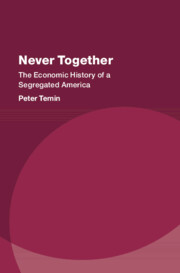Book contents
- Never Together
- Studies in New Economic Thinking
- Never Together
- Copyright page
- Dedication
- Contents
- Figures
- Tables
- Preface
- Introduction
- Part I The Nineteenth Century
- Part II The Twentieth Century
- Chapter 4 Wars and the Great Migration
- Chapter 5 Postwar Prosperity and Civil Rights
- Chapter 6 The New Gilded Age and Mass Incarceration
- Part III The Twenty-First Century
- References
- Index
Chapter 5 - Postwar Prosperity and Civil Rights
from Part II - The Twentieth Century
Published online by Cambridge University Press: 10 February 2022
- Never Together
- Studies in New Economic Thinking
- Never Together
- Copyright page
- Dedication
- Contents
- Figures
- Tables
- Preface
- Introduction
- Part I The Nineteenth Century
- Part II The Twentieth Century
- Chapter 4 Wars and the Great Migration
- Chapter 5 Postwar Prosperity and Civil Rights
- Chapter 6 The New Gilded Age and Mass Incarceration
- Part III The Twenty-First Century
- References
- Index
Summary
The years of prosperity after World War II are known as Les Trente Glorieuses. But while they were glorious for white Americans, African Americans were left out of the economic expansion. The Great Migration continued as Blacks tried to improve their lot, but good jobs were getting more scarce as the economy was experiencing technical change that destroyed factory work. Blacks were cut out of the GI bill because it was administered by states. Blacks therefore could not get good education for the new technology, mortgages for houses in the new suburbs, and were often denied membership in unions. Brown v. Board of Education was designed to create integrated classrooms, but whites moved to private schools and suburbs to avoid integration. Lyndon Johnson’s 1965 Voting Act provided wars to outlaw Jim Crow laws, but it was severely limited in its effect by the Supreme Court. Some Blacks were able to get a good education and graduate from college. They became a Black Elite.
Keywords
- Type
- Chapter
- Information
- Never TogetherThe Economic History of a Segregated America, pp. 159 - 182Publisher: Cambridge University PressPrint publication year: 2022



